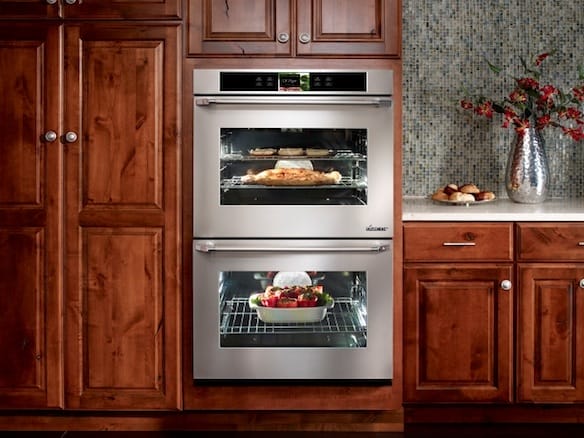
Image credit: PC Mag.
Oven Insider Guide
For many of us, a versatile kitchen range is enough. Whether the heating elements are gas or electric, we can cook on its stovetop, bake and roast in its oven, and broiler under the broiling element. For others, especially those who get serious about what’s going on the table, a range isn’t enough. You’re just doing too much baking and roasting, and need specialized equipment. If you’re one of those people, a dedicated oven is just the ticket.
Modern ovens come in different configurations. If you’re in the market for one, this article walks you through your decision tree. The first things you’ll want to before buying something, though, is both measure your space and figure out your installation. Stand alone wall ovens aren’t like ranges. They don’t come on wheels. Make sure that you know how and where your oven will go before you buy it, and that it can be installed without a major home improvement job.
Once your space is squared away – and be sure that the mounting will give you easy access for sliding what you’re cooking in and out! — your main choices are going to be whether you want a single or double oven, and whether you want the heating element to be electric or gas. After that, there are special features to consider.
Single or Double?
Single wall ovens are just that. They give you a single option. You’ll be cooking one thing at a time. Of course, since most people have kitchen ranges with ovens in them, you’ve effectively got two ovens in your kitchen already. The advantages of single wall ovens are space and cost. They’ve got a smaller footprint – well, wallprint! – than double ovens, and they tend to be somewhat less expensive as well.
Double wall ovens can take your kitchen to a whole new level. With one oven mounted above the other, you’ve got twice the cooking possibilities. Want to serve fresh-baked cookies for dessert, but don’t want the chocolate chips to be tainted by the aroma of the whole salmon you’re making as an entrée? Do the salmon in the top oven and the cookies in the bottom. You can even time your prep so that the cookies will be ready just after dinner. The double oven gives you cooking flexibility. If you entertain a lot, or even have a large family, the double configuration can be a godsend.
Double ovens may be safer if there are little kids in your house. The oven in your kitchen range can be opened by anyone at oven-level…including a toddler. Those double ovens give you the option of doing your baking in the oven with more altitude. It’s unlikely that any child will be able to open the oven on top.
The cost of a double oven is more than that of a single oven, but not prohibitively more. There are double ovens advertised that cost no more than fifteen or twenty percent more than the single oven. The flexibility and safety may be worth it.
Finally, there are double ovens that combine a conventional oven on the bottom and a microwave on top. If you do a lot of microwaving, this could be a good choice.
Electric or Gas?
Those buying a wall oven face the same choice as do those buying kitchen ranges. Should the oven be electric or gas?
Both are good options, with the gas oven costing somewhat less to operate over the course of a year than its electric-powered cousin. There are professional chefs who use each. Some lean toward gas, because gas heat is a bit more moist than electric heat, and might help carmelize and crust food surfaces a tad better. On the other hand, the electric oven might deliver slightly more consistent heat than the gas unit. It all comes down to personal preference. If you’ve always baked in a gas oven, you’re probably going to stick with that…assuming that the gas line is there for you to connect!
Take a look too at the programming options available on the oven you’re considering. That programming may be more important to you, in the long run, than whether the oven is gas or electric.
Extra Points
Whether the oven is gas or electric, an interior fan help distribute the heat eliminate hotspots. Your food will cook more evenly as a result.
Like gunsights, ovens are calibrated. When you type in a particular temperature, the oven should deliver that temperature. However, as with gunsights, calibration may vary in its precision. Therefore, invest the few dollars in a great kitchen thermometer and test the oven’s accuracy before you start baking or roasting. You may find that you must set your temperature a few degrees higher or lower than what’s called for in your recipe.



